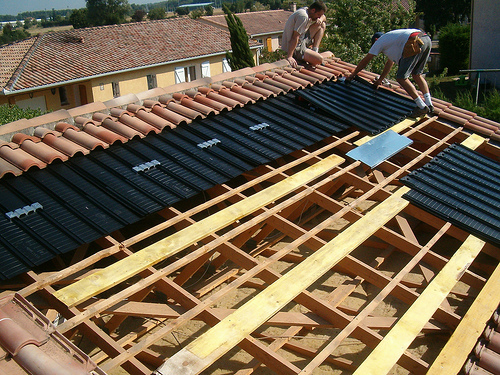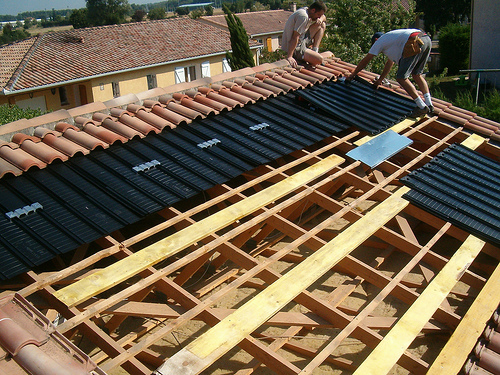 Roof retrofitting is going to require the private financial system.Photo: David TreboscThis post was originally published on The Energy Blog, a project with National Geographic’s Great Energy Challenge and Planet Forward.
Roof retrofitting is going to require the private financial system.Photo: David TreboscThis post was originally published on The Energy Blog, a project with National Geographic’s Great Energy Challenge and Planet Forward.
The sad truth is that if you want to learn about or work on energy efficiency, you need to understand the world of finance. Many of us in the energy/environment field (especially those working on policy) are more comfortable talking about efficiency ratings than credit ratings. But implementing energy efficiency projects at the scale we need will require large sums of money moving through our financial system.
Government programs are all well and good, but they are necessarily limited by the amount of money we can convince politicians to spend, and even the most generous programs can only scratch the surface. For example, the Department of Energy’s Better Buildings program is aimed at retrofitting homes for energy efficiency and has been granted about $500 million for local and regional efficiency programs. But with over 100 million households in the nation, if we want to retrofit even a tiny fraction of those, say one percent, it will take 10 to 20 times more money than the DOE can put into it.
If we want to make a dent in household energy efficiency, we will need to move large amounts of private capital. That money will not move unless the financials look good, because unlike the DOE, private investors are not in the habit of giving their money away without good prospects of getting it back with interest.
Unfortunately, this makes everything a little messier and a little more complicated than we might like. Sticking with residential retrofits as an example, one of the obstacles to getting home retrofits done is that, in relative terms, the up front costs of a project are pretty high. Doing a thorough energy audit and whole home retrofit can cost anywhere between five and ten thousand dollars. This is an expense in the neighborhood of buying a car, except that for many people, owning a car is essential for daily life, and a home retrofit isn’t.
Most people won’t have that amount of cash on hand to spend on a project like this, and just like buying a car, they will need to finance some of all of the project costs. In the best case scenario, a homeowner would have access to some type of home equity loan or line of credit. Right now, these carry interest rates of somewhere around four percent. Combined with the fact that the interest on these loans is usually tax deductible, this is a pretty affordable option.
Unfortunately, many homeowners don’t have ready access to home equity financing, and in the current environment of falling home values, many will be unwilling or unable to go through the process of getting it.
At the other end of the interest rate spectrum is credit card debt. Most home owners have access to credit cards and might be able to put a project of this size on their cards, but average interest rates for credit cards and other so-called “unsecured consumer debt” is around 15 percent. Rates like this will make virtually any retrofit project uneconomical.
Turning to a bank is not much better. From a bank’s perspective, these loans look a lot more like unsecured consumer debt than anything else. Unlike a car loan, which you can get for about six percent if you have good credit, retrofit loans don’t have anything the bank can repossess if you don’t pay. Home equity loans have low interest rates because banks can put a lien on your house if you don’t pay, so they can get paid back when you sell your house. Here, it’s virtually impossible for a bank to come in and repossess your insulation or new windows, which makes the loan inherently more risky and the interest rate much higher.
This leaves the retrofit market in something of a bind. Fortunately, the situation is not impossible, and there have been a handful of proposals and finance vehicles designed to offer a way out of this bind. Starting with my next post, I’ll run through some of these, starting with the ill-fated Property Assessed Clean Energy program.



